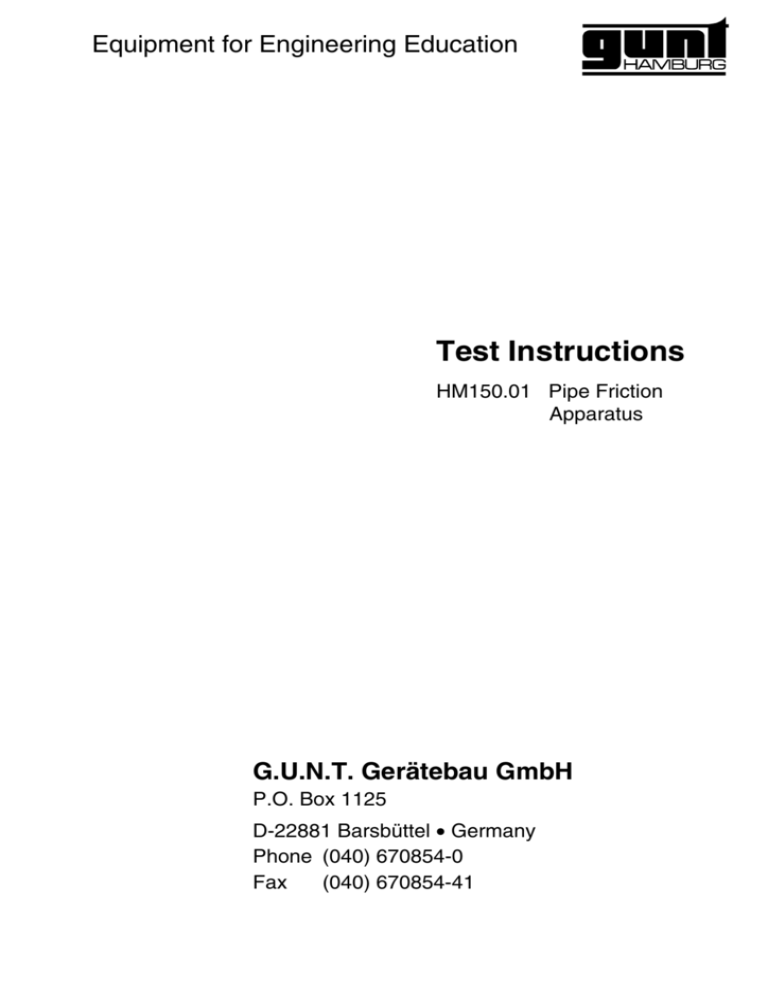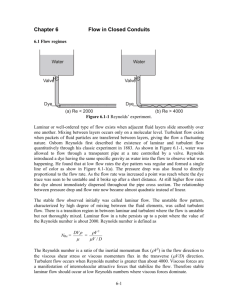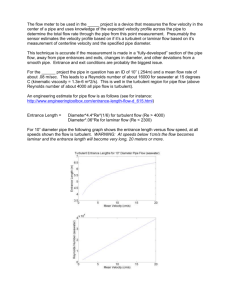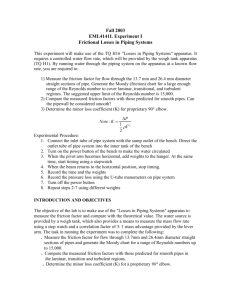
Equipment for Engineering Education
Test Instructions
HM150.01 Pipe Friction
Apparatus
G.U.N.T. Gerätebau GmbH
P.O. Box 1125
D-22881 Barsbüttel • Germany
Phone (040) 670854-0
Fax
(040) 670854-41
All rights reserved G.U.N.T. Gerätebau GmbH, Barsbüttel , Germany, 12/96
HM150.01 Pipe Friction Apparatus
Test Instructions
Publication no.: 917.00001A15012
12/96
HM150.01 Pipe Friction Apparatus
Contents
1 Unit description . . . . . . . . . . . . . . . . . . . . . . . . . . . . . . . . . . . . . . 2
2 Preparing the experiment . . . . . . . . . . . . . . . . . . . . . . . . . . . . . . 4
All rights reserved G.U.N.T. Gerätebau GmbH, Barsbüttel , Germany, 12/96
3 Experiments . . . . . . . . . . . . . . . . . . . . . . . . . . . . . . . . . . . . . . . . 4
3.1
Laminar flow. . . . . . . . . . . . . . . . . . . . . . . . . . . . . . . . . . . . . . . . . . . . 4
3.2
Measured values for laminar flow . . . . . . . . . . . . . . . . . . . . . . . . . . . 7
3.3
Turbulent flow. . . . . . . . . . . . . . . . . . . . . . . . . . . . . . . . . . . . . . . . . . . 8
3.4
Measured values for turbulent flow . . . . . . . . . . . . . . . . . . . . . . . . . 10
3.5
Graph of measured values. . . . . . . . . . . . . . . . . . . . . . . . . . . . . . . . 11
1
HM150.01 Pipe Friction Apparatus
1
Unit description
The HM150.01 unit is used to examine pipe friction
losses in laminar and turbulent flow.
The pipe section used is a brass pipe with an inside
diameter of 3 mm and a length of 400 mm.
The pressure losses are measured in laminar flow
with a water manometer. The static pressure difference is indicated.
All rights reserved G.U.N.T. Gerätebau GmbH, Barsbüttel , Germany, 12/96
In turbulent flow the pressure difference is measured with a mercury-filled U-tube manometer.
A level tank is provided to generate the laminar
flow. It ensures a constant water inflow pressure
on the pipe section at a constant water level.
The level tank is not used to generate turbulent
flow. The water is fed directly from the water main
into the pipe section.
The flow rate is set by means of needle valves at
each end of the pipe.
The water is supplied either from the HM150 fluid
technics base module or from the laboratory main.
An enclosed water circuit can be established with
the HM150.
1 Unit description
2
HM150.01 Pipe Friction Apparatus
The unit basically comprises:
12
1
2
All rights reserved G.U.N.T. Gerätebau GmbH, Barsbüttel , Germany, 12/96
11
10
9
8
3
7
5
6
1
Demonstration board
7
Inlet needle valves
2
U-Tube manometer
8
3
Discharge needle valve
Hose connection
Water supply
4
Pressure tapping at the
end of the pipe
9
Ball cock
5
Pressure tapping at the
beginning of the pipe
11 Water tank
6
Pipe section
1 Unit description
4
10 Overflow
12 Water manometer
3
HM150.01 Pipe Friction Apparatus
All rights reserved G.U.N.T. Gerätebau GmbH, Barsbüttel , Germany, 12/96
2
Preparing the experiment
3
-
Set up the experiment on the HM150
so that the discharge directs the water into
the sewer.
-
Connect a hose between the HM150 and the
unit.
-
Open the HM150 discharge.
Experiments
Pressure lost of laminar flow is to be compared
with turbulent flow.
3.1
Laminar flow
-
Connect the water manometer to the two
pressure measuring nipples.
-
Open the needle valve at the discharge fully.
-
Close the valve [1] fully.
-
Open the valve [2] fully.
-
Switch the HM150 pump on and adjust the
ball-cock so that a constant water level is
created at the overflow.
Overflowf
Level
Valve [2]
Ball cock
Valve[1]
2 Preparing the experiment
4
All rights reserved G.U.N.T. Gerätebau GmbH, Barsbüttel , Germany, 12/96
HM150.01 Pipe Friction Apparatus
-
Close the needle valve at the discharge until
a constant pressure difference of 2 cm is established on the water manometer.
This corresponds to the fall hv.
-
Determining the volume flow.
-
Increase the flow in increments (hv increases) and repeat the volume flow measurements.
Discharge
needle valve
It also needs to be investigated whether the flow
is laminar or turbulent.
The switch from laminar to turbulent flow form
occurs when:
Hose connection
Rekr ≈ 2300
Relam. ≤ 2300 means laminar flow
Retur. ≥ 2300 means turbulent flow
The Reynolds number is calculated from
Re =
hv
w⋅d
ν
where
d= inside diameter of the pipe section [m]
h1
w= flow rate [m/s]
h2
Mearurement of the fall hv
on the water manometer
ν= viscosity of the medium [m2/s]
Fall hv = h1 − h2
h1: static pressure at the entrance to the pipe.
3 Experiments
5
HM150.01 Pipe Friction Apparatus
.
The volume flow V is best measured with a measuring vessel and a stopwatch.
V
.
V = t
The flow rate is produced from:
.
V
w=
A
All rights reserved G.U.N.T. Gerätebau GmbH, Barsbüttel , Germany, 12/96
.
V= volume flow
A= cross-sectional area of the pipe
π ⋅ d2
where A =
and d = 3 mm.
4
The fall hv is set with the drain valve. From the fall
the pipe coefficient of friction is calculated λ as:
λ=
2 ⋅ hv ⋅ d
ρH2o ⋅ l ⋅ w2
where l = 400 mm pipe section, the value for
hv has to be inserted in Pa
The theoretical pipe coefficient of friction λth is to
be compared with the measured value. For laminar
flow:
64
λth = Re
3 Experiments
6
HM150.01 Pipe Friction Apparatus
3.2
Measured values for laminar flow
The following measured values were produced for
laminar flow. While performing the experiment,
ensure that the water level in the tank remains
constant.
All rights reserved G.U.N.T. Gerätebau GmbH, Barsbüttel , Germany, 12/96
Measured values:
3 Experiments
hv
[cm]
t
[s]
V
[l]
.
V
[l/s]
w
[m/s]
Re
λ
λth
(calculated)
2
195
0,2
0,00102
0,144
403
0,141
0,158
3
138
0,2
0,00145
0,205
574
0,105
0,114
4
105
0,2
0,00190
0,265
754
0,081
0,085
5
78
0,2
0,00256
0,362
1014
0,056
0,063
6
72
0,2
0,00277
0,391
1096
0,057
0,058
8
58
0,2
0,00344
0,486
1362
0,050
0,047
15
77
0,4
0,00519
0,734
2060
0,040
0,031
7
HM150.01 Pipe Friction Apparatus
3.3
Turbulent flow
All rights reserved G.U.N.T. Gerätebau GmbH, Barsbüttel , Germany, 12/96
In this experiment the level tank is not used. For
turbulent flow a higher flow rate is required. The
water is therefore fed directly from the HM150 or
from the main into the pipe section. Proceed as
follows:
-
Close the ball-cock fully.
-
Close valve [2] fully.
-
Close valve [1] fully.
-
Connect the Mercury U-tube manometer to
the two pressure measuring nipples.
-
Open the needle valve at the discharge fully.
-
Switch the HM150 pump on.
-
Open valve [1] fully.
Valve [2]
Ball cock
Valve [1]
Discharge
needle valve
Hose connections
3 Experiments
8
All rights reserved G.U.N.T. Gerätebau GmbH, Barsbüttel , Germany, 12/96
HM150.01 Pipe Friction Apparatus
-
Close the needle valve at the discharge until
a constant pressure difference of 20 mbar is
established on the U-tube manometer.
This corresponds to a fall hv of 15 mm.
(1 mm Mercury Column = 1,33322 mbar)
-
Determining the volume flow.
-
Increase the flow in increments (hv increases) and repeat the volume flow measurements.
Fall hv = h1 − h2
hv
h1: static pressure at the entrance to the
pipe section.
h1
h2
Measurement of the Fall hv
on the U-tube manometer
h2: static pressure at the outlet from the
pipe section.
The calculations are made in the same way as for
the laminar flow.
According to Blasius, however, the theoretical pipe
coefficient of friction λth
for turbulent flow is calculated as follows:
λth =
3 Experiments
0,3164
4
Re
√
9
HM150.01 Pipe Friction Apparatus
3.4
Measured values for turbulent flow
The following measured values were produced for
turbulent flow.
All rights reserved G.U.N.T. Gerätebau GmbH, Barsbüttel , Germany, 12/96
Measured values:
∆p
[mbar]
t
[s]
V
[l]
.
V
[l/s]
w
[m/s]
Re
λ
λth
(calculated)
20
67,42
0,40
0,0059
0,838
2349
0,0420
0,0454
30
5791
0,40
0,0069
0,976
2736
0,0460
0,0437
40
46,09
0,40
0,0086
1,22
3420
0,0390
0,0413
60
3545
0,40
0,0112
1,59
4458
0,0348
0,0387
80
32,79
0,40
0,0121
1,724
4834
0,0395
0,0379
100
27,91
0,40
0,0143
2,027
5683
0,0357
0,0364
120
25,48
0,40
0,0157
2,22
6224
0,0358
0,0356
140
22,47
0,40
0,0178
2,52
7066
0,0324
0,0345
160
21,26
0,40
0,0188
2,66
7957
0,0330
0,0335
200
19,31
0,40
0,0207
2,93
8214
0,0342
0,0332
3 Experiments
10
HM150.01 Pipe Friction Apparatus
3.5
Graph of measured values
λ
0,12
Coefficient of pipe friction
All rights reserved G.U.N.T. Gerätebau GmbH, Barsbüttel , Germany, 12/96
0,14
0,10
0,08
0,06
0,04
0,02
1000
Laminar
3000
5000
7000
Re
Turbulent
Reynolds number
λ
measured
λth theoretical
3 Experiments
11








